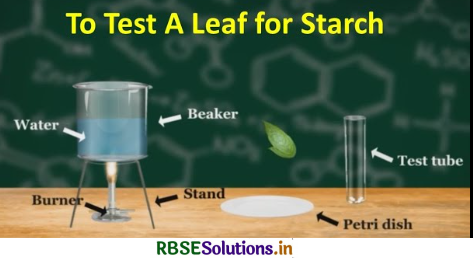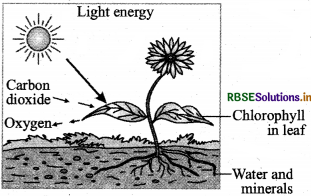RBSE Solutions for Class 7 Science Chapter 1 Nutrition in Plants
Rajasthan Board RBSE Solutions for Class 7 Science Chapter 1 Nutrition in Plants Textbook Exercise Questions and Answers.
Rajasthan Board RBSE Solutions for Class 7 Science in Hindi Medium & English Medium are part of RBSE Solutions for Class 7. Students can also read RBSE Class 7 Science Important Questions for exam preparation. Students can also go through RBSE Class 7 Science Notes to understand and remember the concepts easily. The class 7 science chapter 4 heat extra questions are curated with the aim of boosting confidence among students.
RBSE Class 7 Science Solutions Chapter 1 Nutrition in Plants
RBSE Class 7 Science Nutrition in Plants InText Questions and Answers
Page 1
Question 1.
Boojho wants to know how plants prepare their own food?
Answer:
Green plants can make their own food from simple substances like CO2 and water present in the surroundings by the process of photosynthesis. In plants, water and minerals present in the soil are absorbed by roots and CO2 is taken from air through stomata. The leaves.have green pigment called chlorophyll, which helps to attain the energy from sunlight. Hence, the leaves containing chlorophyll synthesize carbohydrate in the presence of CO2, H2O and sunlight.


Question 2.
Paheli wants to know why our body cannot make food from carbon dioxide, water and minerals like plants do?
Answer:
Our body cannot make food from carbon dioxide, water and minerals like plants do because our body has no chlorophyll which can absorb the solar energy. The solar energy is used to synthesize food from CO2 and water.
Page 2
Question 3.
Boojho wants to know how water and minerals absorbed by roots reach to the leaves?
Answer:
Water and minerals are transported to the leaves by the vessels (xylem) which run like pipes throughout the roots, the stem, the branches and the leaves. These vessels form a continuous path or passage for the nutrients to reach the leaf.
Question 4.
Paheli wants to know what is so special about the leaves that they can synthesis food but other parts of the plant cannot?
Answer:
The leaves have green pigment called chlorophyll. It helps leaves to absorb the energy of sunlight to synthesize food. That is why, the leaves can synthesize food hut other parts of the plant cannot.
Page 3
Question 5.
Boojho has observed some plants with deep red, violet or brown leaves. He wants to know whether these leaves also carry out photosynthesis.
Answer:
Yes, these leaves also carry out the process of photosynthesis because they contain chlorophyll.
Page 5
Question 6.
Paheli wants to know whether mosquitoes, bedbugs, lice and leeches that suck our blood are also parasites.
Answer:
Parasites are those organisms which feed and derive nourishment from other organism. Parasites live on the host permanently. However, bedbugs, lice and leeches are not actually parasites. They may feed on our blood but they certainly don’t live and depend on us.
Question 7.
Boojho is confused if the pitcher plant is green and carries out photosynthesis then why does it feed on insects?
Answer:
Pitcher plant is the insectivorous plant. It grows in soil which is deficient in nitrogen. It is green in colour and carries out photosynthesis to prepare part of its own food. But, to meet nitrogen requirements, insectivorous pitcher plants feed on insects.
Page 6
Question 8.
Boojho wants to know how saprotrophs acquire nutrients. They do not have mouth like animals do. They are not like green plants as they lack chlorophyll and cannot make food by photosynthesis.
Answer:
These organisms have a different mode of nutrition. They secrete digestive juices on the dead and decaying matter and convert it into a solution then they absorb the nutrients from it.
Question 9.
Paheli is keen to know whether her beautiful shoes which she wore on special occasions were spoiled by fungi during the rainy season. She wants to know how fungi appear suddenly during the rainy season.
Answer:
The fungi spores are generally present in the air and grow on articles (like pickles, clothes, leather shoes etc.) that are left in hot and humid weather for a long time during rainy season.
Page 7
Question 10.
Boojho says once his grandfather told him that his wheat fields were spoiled by a fungus. He wants to know if fungi cause diseases also.
Answer:
There are many fungi like yeast and mushroom, which are useful. But some fungi cause diseases in plants, animals and humans, so to conclude, fungi can cause diseases also.
RBSE Class 7 Science Nutrition in Plants Textbook Questions and Answers
Question 1.
Why do organisms take food?
Answer:
Food is essential for all living organisms. It has following roles:
(a) Food provides energy for growth and maintenance of the body parts.
(b) It provides essential nutrients to organisms to carry out various life processes.
(c) It is needed to repair damaged parts of their bodies.

Question 2.
Distinguish between a parasite and a saprotroph.
Answer:
Differences between a parasite and a saprotroph are as follows:
|
Parasite |
Saprotroph |
|
A parasite feeds on living organisms. |
A saprotroph feeds on dead and decaying organisms. |
|
A parasite feeds |
A saprotroph secrets digestive juices on the organic matter, converts it into a solution and then absorbs it. |
|
Example: Cuscuta, tapeworm |
Example: Fungi and many bacteria. |
Question 3.
How would you test the presence of starch in leaves?
Answer:
Presence of starch in leaves can be detected by iodine test.
Principle: Iodine solution turns starch into blue - black colour.
Procedure:
- The leaf to be tested is put in a test tube containing ethyl alcohol.
- It is gently heated in a water bath until alcohol begins to boil.
- The colourless leaf is removed from alcohol and washed thoroughly with water.
- Then the leaf is placed in a petri dish and few drops of iodine solution is poured over it.

Observation: The presence of starch in leaves is detected by the appearance of blue - black colour after pouring few drops of iodine solution.
Question 4.
Give a brief description of the process of synthesis of food in green plants.
Answer:
The leaves have green pigment called chlorophyll. It helps leaves to gain energy of the sunlight. The energy is used to synthesis food from carbon dioxide and water in the presence of sunlight. This is called photosynthesis. Thus, we conclude that chlorophyll, sunlight, carbon dioxide and water are necessary and solar energy captured by the leaves is plants in the form of food.


Question 5.
Show with the help of a sketch that plants are the ultimate source of food.
Answer:

Question 6.
Fill in the blanks:
(a) Green plants are called ....................... since they synthesise their own food.
(b) The food synthesized by the plants is stored as .......................
(c) In photosynthesis solar energy is absorbed by the pigment called .......................
(d) During photosynthesis plants take in ....................... and release ....................... gas.
Answer:
(a) autotrophs
(b) starch
(c) chlorophyll
(d) carbon dioxide, oxygen.
Question 7.
Name the following:
(a) A parasitic plant with yellow, slender and branched stem.
(b) A plant that is partially autotrophic.
(c) The pores through which leaves exchange gases.
Answer:
(a) Cuscuta
(b) Pitcher plant
(c) Stomata.
Question 8.
Tick the correct answer:
(a) Cuscuta is an example of:
(i) autotroph
(ii) parasite
(iii) saprotroph
(iv) host
Answer:
(ii) parasite.
(b) The plant which traps and feeds on insects is:
(i) cuscuta
(ii) china rose
(iii) pitcher plant
(iv) rose
Answer:
(iii) pitcher plant.

Question 9.
Match the items given in column I with those in column II
|
Column I |
Column II |
|
1. Chlorophyll |
(a) rhizobium |
|
2. Nitrogen |
(b) heterotrophs |
|
3. Cuscuta |
(c) pitcher plant |
|
4. Animals |
(d) leaf |
|
5. Insects |
(e) parasite |
Answer:
|
Column I |
Column II |
|
1. Chlorophyll |
(d) leaf |
|
2. Nitrogen |
(a) rhizobium |
|
3. Cuscuta |
(e) parasite |
|
4. Animals |
(b) heterotrophs |
|
5. Insects |
(c) pitcher plant |
Question 10.
Mark 'T' if the statement is true and ‘F’ if it is false:
(i) Carbon dioxide is released during photosynthesis.(T/F)
(ii) Plants which synthesize their food are called saprotrophs.(T/F)
(iii) The product of photosynthesis is not a protein. (T/F)
(iv) Solar energy is converted into chemical energy during photosynthesis. (T/F)
Answer:
(i) False
(ii) False
(iii) True
(iv) True.
Question 11.
Choose the correct option from the following:
Which part of the plant takes in carbon dioxide from the air for photosynthesis?
(i) Root hair
(ii) Stomata
(iii) Leaf veins
(iv) Petals
Answer:
(ii) Stomata; these are tiny pores present on leaves which help in gaseous exchange.
Question 12.
Choose the correct option from the following:
Plants take carbon dioxide from the atmosphere mainly through their:
(i) roots
(ii) stem
(iii) flowers
(iv) leaves
Answer:
(iv) Leaves; they have stomata through which gaseous exchange takes place.
Question 13.
Why do farmers grow many fruits and vegetable crops inside large green houses? What are the advantages to the farmers?
Answer:
Farmers grow many fruit and vegetable crops inside large green houses because green house provide favourable conditions for these crops. A green house is built from the materials which allow sunlight to pass through it and provide warmer temperature for growing fruits and vegetables.
The advantages which farmers get through this process is:
- Crops grow well.
- Crops are protected from high blowing wind and rodents.
- Crops are also protected from birds and animals.

- RBSE Class 7 Science Notes in Hindi & English Medium Pdf Download
- RBSE Class 7 Science Important Questions in Hindi Medium & English Medium
- RBSE Solutions for Class 7 Science in Hindi Medium & English Medium
- RBSE Class 7 Science Important Questions Chapter 1 Nutrition in Plants
- RBSE Class 7 Science Notes Chapter 1 Nutrition in Plants
- RBSE Class 7 Science Important Questions Chapter 14 Electric Current and its Effects
- RBSE Class 7 Science Important Questions Chapter 13 Motion and Time
- RBSE Class 7 Science Important Questions Chapter 2 Nutrition in Animals
- RBSE Class 6 Science Notes Chapter 8 शरीर में गति
- RBSE Class 7 Science Notes Chapter 18 Wastewater Story
- RBSE Class 7 Science Notes Chapter 17 Forests: Our Lifeline